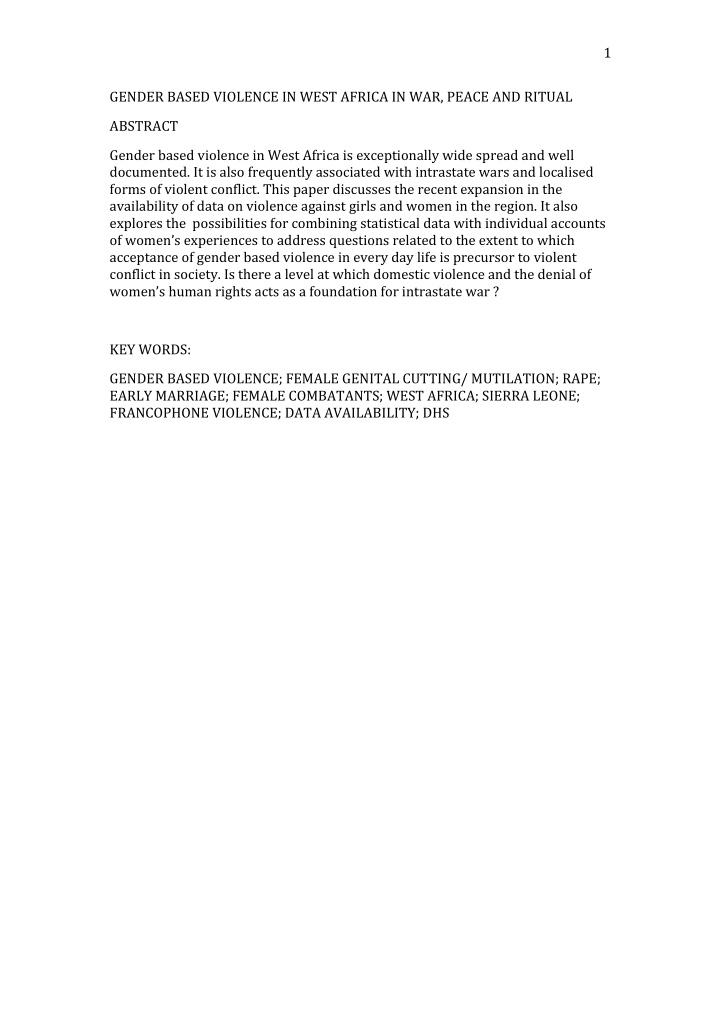



¡ 1 ¡ GENDER ¡BASED ¡VIOLENCE ¡IN ¡WEST ¡AFRICA ¡IN ¡WAR, ¡PEACE ¡AND ¡RITUAL ¡ ABSTRACT ¡ ¡ Gender ¡based ¡violence ¡in ¡West ¡Africa ¡is ¡exceptionally ¡wide ¡spread ¡and ¡well ¡ documented. ¡It ¡is ¡also ¡frequently ¡associated ¡with ¡intrastate ¡wars ¡and ¡localised ¡ ¡ forms ¡of ¡violent ¡conflict. ¡This ¡paper ¡discusses ¡the ¡recent ¡expansion ¡in ¡the ¡ availability ¡of ¡data ¡on ¡violence ¡against ¡girls ¡and ¡women ¡in ¡the ¡region. ¡It ¡also ¡ explores ¡the ¡ ¡possibilities ¡for ¡combining ¡statistical ¡data ¡with ¡individual ¡accounts ¡ of ¡women’s ¡experiences ¡to ¡address ¡questions ¡related ¡to ¡the ¡extent ¡to ¡which ¡ acceptance ¡of ¡gender ¡based ¡violence ¡in ¡every ¡day ¡life ¡is ¡precursor ¡to ¡violent ¡ conflict ¡in ¡society. ¡Is ¡there ¡a ¡level ¡at ¡which ¡domestic ¡violence ¡and ¡the ¡denial ¡of ¡ women’s ¡human ¡rights ¡acts ¡as ¡a ¡foundation ¡for ¡intrastate ¡war ¡? ¡ ¡ ¡ KEY ¡WORDS: ¡ ¡ GENDER ¡BASED ¡VIOLENCE; ¡FEMALE ¡GENITAL ¡CUTTING/ ¡MUTILATION; ¡RAPE; ¡ EARLY ¡MARRIAGE; ¡FEMALE ¡COMBATANTS; ¡WEST ¡AFRICA; ¡SIERRA ¡LEONE; ¡ FRANCOPHONE ¡VIOLENCE; ¡DATA ¡AVAILABILITY; ¡DHS ¡ ¡ ¡ ¡ ¡ ¡ ¡ ¡ ¡ ¡ ¡ ¡ ¡ ¡ ¡ ¡ ¡ ¡ ¡
¡ 2 ¡ GENDER ¡BASED ¡VIOLENCE ¡IN ¡WEST ¡AFRICA ¡IN ¡WAR, ¡PEACE ¡AND ¡RITUAL ¡ INTRODUCTION ¡ ¡ This ¡paper ¡has ¡two ¡core ¡objectives. ¡ ¡Firstly, ¡to ¡introduce ¡some ¡of ¡the ¡vast ¡array ¡of ¡ data ¡which ¡has ¡become ¡available ¡in ¡recent ¡years ¡on ¡women ¡and ¡violence ¡in ¡West ¡ Africa. ¡ ¡Secondly, ¡drawing ¡on ¡that ¡data, ¡to ¡discuss ¡the ¡interrelationships ¡between ¡ various ¡forms ¡of ¡gender ¡based ¡violence ¡in ¡peace ¡and ¡war ¡time ¡and ¡to ¡propose ¡ that ¡societies ¡which ¡have ¡high ¡levels ¡of ¡gender ¡based ¡violence ¡in ¡peace ¡time ¡also ¡ tend ¡to ¡experience ¡intrastate ¡wars ¡and ¡to ¡suffer ¡extremely ¡violent ¡conflicts ¡in ¡ which ¡women ¡are ¡singled ¡out ¡for ¡victimization. ¡ Sadly, ¡West ¡Africa ¡is ¡a ¡region ¡where ¡there ¡is ¡a ¡great ¡deal ¡of ¡violence, ¡both ¡in ¡war ¡ and ¡in ¡peace. ¡Even ¡in ¡war ¡time ¡much ¡of ¡the ¡violence ¡affects ¡civilians ¡as ¡much ¡as ¡ or ¡even ¡more ¡than ¡combatants. ¡In ¡peace ¡time, ¡denials ¡of ¡women’s ¡basic ¡human ¡ rights ¡are ¡associated ¡with ¡cultures ¡in ¡which ¡structural ¡violence ¡perpetrated ¡ against ¡girls ¡and ¡women ¡is ¡the ¡norm ¡not ¡the ¡exception. ¡ Although ¡researchers ¡would ¡always ¡like ¡more ¡data, ¡over ¡the ¡past ¡two ¡decades ¡a ¡ vast ¡array ¡of ¡data ¡has ¡become ¡available ¡relating ¡to ¡gender ¡in ¡West ¡Africa ¡(eg. ¡ WISTAT ¡76 ¡indicators; ¡GenderStats ¡ ¡21 ¡and ¡World ¡Economic ¡Forum’s ¡Gender ¡ Gap ¡Project ¡33). ¡Beyond ¡the ¡UNDP’s ¡Gender ¡Inequality ¡Index ¡(GII) ¡is ¡the ¡ ¡ Economic ¡Commission ¡of ¡Africa’s ¡highly ¡ambitious ¡African ¡Gender ¡and ¡ Development ¡Index ¡ ¡(AGDI), ¡including ¡the ¡African ¡Women’s ¡Progress ¡Scoreboard ¡ (AWPS), ¡launched ¡in ¡2004 ¡and ¡still ¡under ¡development. ¡It ¡should ¡thus ¡now ¡be ¡ inexcusable ¡to ¡continue ¡to ¡use ¡the ¡total ¡fertility ¡rate ¡as ¡a ¡proxy ¡for ¡the ¡status ¡of ¡ women ¡(as ¡in ¡Caprioli ¡2005; ¡Cohen ¡2013; ¡Thomas ¡and ¡Wood ¡2017). ¡ ¡ The ¡most ¡extensive ¡data ¡on ¡violence ¡is ¡found ¡in ¡the ¡multiple ¡reports ¡of ¡the ¡ Demographic ¡and ¡Health ¡Surveys ¡(DHS) ¡for ¡countries ¡across ¡the ¡region. ¡ Beginning ¡in ¡1997 ¡the ¡DHS ¡began ¡to ¡integrate ¡measures ¡of ¡empowerment, ¡these ¡ included ¡direct ¡measures ¡of ¡women’s ¡participation ¡in ¡household ¡decisions, ¡ women’s ¡attitudes ¡about ¡wife ¡beating, ¡attitudes ¡about ¡situations ¡when ¡a ¡wife ¡can ¡ refuse ¡to ¡have ¡sex ¡with ¡her ¡husband ¡ ¡and ¡obstacles ¡which ¡women ¡face ¡in ¡ accessing ¡health ¡care. ¡There ¡were ¡ ¡also ¡ ¡optional ¡modules ¡on ¡intimate ¡partner ¡ violence ¡(IPV) ¡and ¡on ¡female ¡genital ¡cutting ¡(FGC). ¡The ¡DHS ¡questions ¡designed ¡ to ¡measure ¡women’s ¡empowerment ¡were ¡originally ¡drawn ¡up ¡in ¡the ¡Asian ¡ context, ¡opening ¡up ¡the ¡question ¡as ¡to ¡how ¡appropriate ¡they ¡are ¡to ¡measurement ¡ in ¡Africa ¡(Schatz ¡and ¡Williams ¡2011). ¡ ¡For ¡example, ¡an ¡experimental ¡study ¡in ¡ rural ¡Northern ¡Uganda ¡showed ¡that ¡responses ¡to ¡questions ¡about ¡the ¡ acceptability ¡of ¡husbands ¡beating ¡their ¡wives ¡were ¡sensitive ¡to ¡the ¡extent ¡to ¡ which ¡the ¡brief ¡vignette ¡showed ¡the ¡wife ¡to ¡be ¡deliberately ¡provocative ¡or ¡ blameless ¡(Tsai ¡et ¡al. ¡2017). ¡ Another ¡major ¡source ¡of ¡data ¡is ¡the ¡ ¡highly ¡informative ¡reports ¡of ¡a ¡number ¡of ¡ individual ¡truth ¡commissions ¡ ¡(especially ¡for ¡Sierra ¡Leone ¡and ¡ ¡Liberia), ¡as ¡well ¡ as ¡specialised ¡follow-‑up ¡studies ¡of ¡particular ¡ ¡areas ¡of ¡violence ¡(Asher ¡et ¡al. ¡ 2004; ¡Gubarek ¡et ¡al. ¡2006; ¡Hussain ¡et ¡al. ¡2014). ¡However, ¡much ¡of ¡the ¡available ¡ data ¡remains ¡largely ¡ignored ¡or ¡is ¡utilised ¡by ¡researchers ¡and ¡field ¡workers ¡who ¡ are ¡confined ¡to ¡particular ¡silos, ¡such ¡as ¡reproductive ¡health, ¡primary ¡education ¡ or ¡military ¡demobilisation ¡and ¡do ¡not ¡interact ¡with ¡those ¡involved ¡with ¡other ¡
Recommend
More recommend